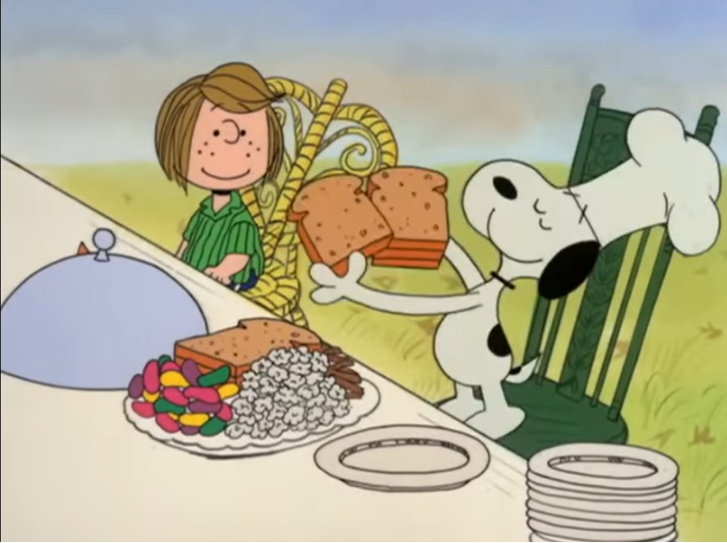Until recently, the narrative of the American Thanksgiving meal has been about togetherness. Inspired perhaps by the Norman Rockwell painting Freedom from Want (1943), which depicts the archetypical American family sharing the archetypical American Thanksgiving feast. The traditional Thanksgiving meal is classic Americana, like Coca-Cola, baseball, or Norman Rockwell. The meal orbits the roast turkey but includes staples like mashed potatoes, sweet potatoes, cranberry sauce, stuffing, and dessert is either a sweet potato pie or the more traditional pumpkin pie. Much of the lore of Thanksgiving comes from the story of colonialism. Indeed, the pilgrims landed on Plymouth Rock. Local Indigenous people, most notably the Wampanoag people, helped the pilgrims survive the harsh winters. Popular history has the pilgrims express their gratitude by celebrating with a feast of thanks.
On November 20, 1973, CBS aired A Charlie Brown Thanksgiving. The titular Charlie Brown is a fretful kid with a preternaturally intelligent beagle, Snoopy. A lively group of children also surrounds Charlie Brown. The magic of Schulz’s work is that the children came to represent the complex and untidy feelings that children have. Children’s television sought to idealize and romanticize childhood. What Schulz did was highlight the angst of youth, primarily through the lens of Charlie Brown.
The plot of A Charlie Brown Thanksgiving is simple and predictable: Charlie Brown is a people pleaser and doesn’t know how to set boundaries. His close friend, Peppermint Patty, the proto-feminist of the Peanuts gang, invites herself to Charlie Brown’s home for Thanksgiving. Eager to please, he stammers to an agreement. This leads to more chaos as Patty invites the other kids, and suddenly Charlie Brown is in charge of a dinner party.
Because food is the central focus of Thanksgiving, it is a significant theme in the special. Schulz’s treatment of food, food preparation, and service is very interesting because he has created a dilemma in his universe: he has crafted a world in which adults are largely absent. No, this is not a fantasy land ruled by children. There are adults in the Peanuts world, though crucially, they don’t speak. Instead, their dialogue is a trombone.
So, in Schulz’s world, children are primarily responsible for themselves, and he has created a situation for his characters in which they must operate simultaneously as independent adults and children. This means that the Thanksgiving feast is improvised and assembled with ingredients and preparation safe for children (as well as an occasionally anthropomorphic dog). To the strains of Vince Guaraldi’s legendary musical theme, Charlie Brown, Snoopy (in a chef’s toque), and Linus set to work to prepare the smorgasbord. As the jazzy piano plays, we see stacks of toast popping out in unison from a phalanx of toasters. Over at the stove, Snoopy is popping corn with the skill of a talented vaudevillian plate spinner. A large table is set in the backyard in anticipation of the guests’ arrival.
With great fanfare, the guests are served their meal. When Snoopy arrives at the table, he solemnly carries a tray with a giant cloche. This kind of presentation is traditional at a Thanksgiving meal. It is almost cliché. The host brings in a tray with a cloche, revealing a steaming, golden brown turkey. But when Snoopy lifts the cloche, he uncovers a different kind of feast: buttered toast, popcorn, a pile of pretzels, and an assortment of jellybeans.
Quickly, the feast is marred by Peppermint Patty’s aggrieved offense at being served such a meal. “What blockhead cooked all this?” she demands. She keeps up with her litany of complaints:
What kind of a Thanksgiving dinner is this? Where’s the turkey, Chuck? Don’t you know anything about Thanksgiving dinner? Where’s the mashed potatoes? Where’s the cranberry sauce? Where’s the pumpkin pie?
Though the haphazardly prepared meal is a funny sight gag and a catalyst for the story’s central conflict, it also serves as a light allegory for the Thanksgiving story itself. The legend of Thanksgiving is about neighborly generosity. Charlie Brown prepared his meal – however meager – because he was generous with his time for his friends whom he loves. The food on the menu represents what Charlie Brown has accessible and what he can prepare, given that he is just a kid. The traditional menu of Thanksgiving has its roots in early American food history, with a lot of classic dishes coming from Native American, Mexican, and South American food traditions (which found their way up north through trading with Native Americans). It is a menu that is derived from food that was created by local populations with ingredients found or brought to the region, as well as, by the food available at certain climates and at certain times of the year. When presented with a plat of rainbow-colored jellybeans and a pile of cotton-like popcorn, Peppermint Patty is essentially served a meal of a very localized region: Charlie Brown’s house.
The resolution has Peppermint Patty apologize and Marcy gives a moving speech about the real meaning of Thanksgiving, saying: “Thanksgiving is more than eating… We should just be thankful for being together. I think that’s what they mean by Thanksgiving, Charlie Brown.”
The food in A Charlie Brown Thanksgiving works on several levels, mainly creating comedy and conflict, but also as an allegory to the history of Thanksgiving.
Peter Piatkowski is a UK-based writer. He has written for a variety of publications, both online and print, and has a blog on cinema, A Seat in the Aisle. His interests include film, literature, television, popular culture, music, and food writing. Along with writing, Peter has also taught for the City Colleges of Chicago. He graduated from the University of Illinois, Chicago with a BA in English, later earning his MA in English Literature from DePaul University, and an MFA in Creative Writing from Roosevelt University.


Lovely story!